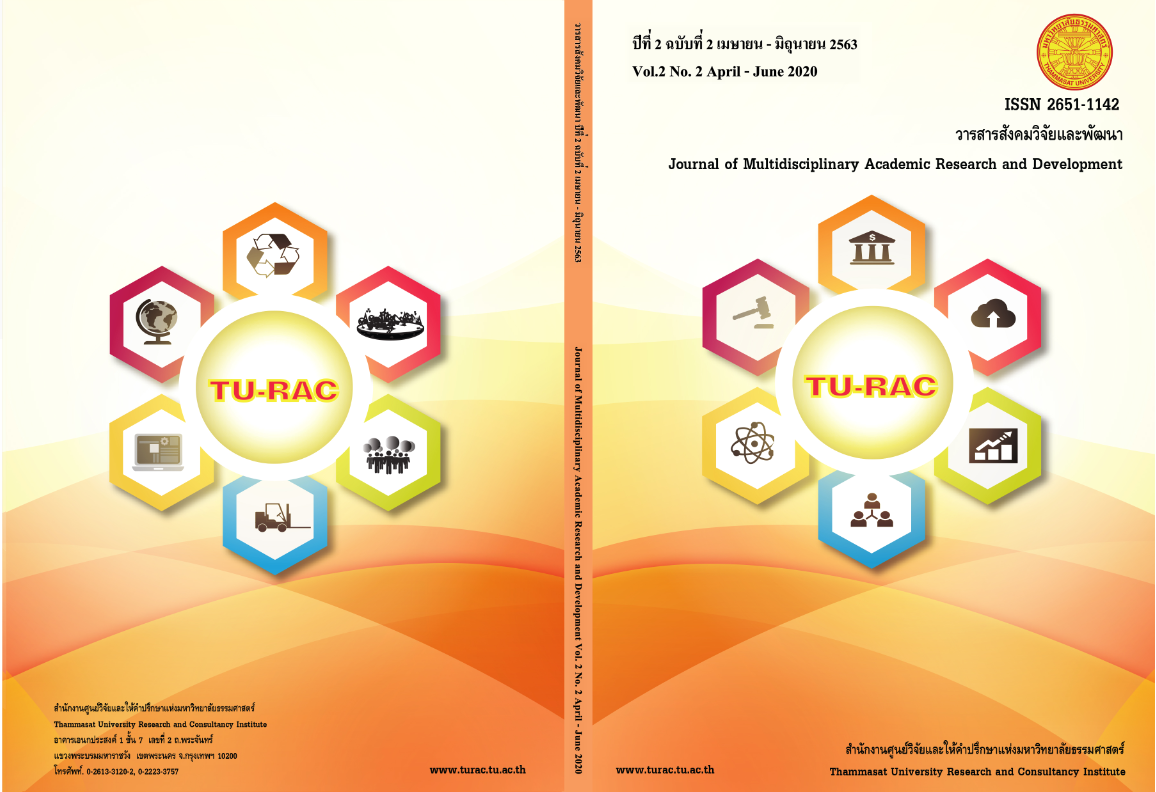The Riparian area, relationship between land utilization and environmental quality Case Study: Tha Chin Watershed
Keywords:
Riparian forest, land development, environmental quality, water qualityAbstract
A riparian area is an environmentally sensitive interface between land and a river or stream, whose degradation may negatively impact water quantity and quality, decreasing natural sediment filtration capacity, and destroying native plant and animal habitats while diminishing recreational facility quality. This article aims to underline the importance of riparian forests by analyzing the status of riparian areas in the Tha Chin watershed, studying the relationship between land use and water quality, and offering guidelines for riparian area conservation and management. A survey revealed that the majority of land utilization in this watershed was agricultural. In urban areas, there is a relationship between the amount of biological oxygen demand (BOD) insofar as when urban areas increase, BOD trend will likewise significantly increase (r = 0.769, Sig. = 0.01). Due to water utilization in urban areas, BOD was at its highest value due to waste water directly discharged into the river. To stabilize the function of natural resources in a normal cycle, there should be a focus on land use planning in terms of water quality by following guidelines to solve riparian problems, such as correcting social mechanisms and solutions through engineering techniques and design.
References
กรมทรัพยากรน้ำ. (2547). โครงการจัดทำแผนรวมการบริหารจัดการทรัพยากรน้ำในพื้นที่ลุ่มน้ำชายฝั่งทะเลตะวันออก. รายงานการศึกษา บริษัท พอล คอนซัลแท็นส์ จำกัด, บริษัท ซิกม่า ไฮโดรคอนซัลแท็นส์ จำกัด. กรุงเทพ : กรมทรัพยากรน้ำ.
กรมพัฒนาที่ดิน. (2560). แผนที่การใช้ที่ดินปี 2551-2559. สืบค้นเมื่อ 15 กรกฎาคม 2560 เข้าถึงได้จาก http://www.ngis.go.th/home/?page_id=928.
ฉัตรไชย รัตนไชย. (2539). การจัดการคุณภาพน้ำ. กรุงเทพ : โรงพิมพ์จุฬาลงกรณ์มหาวิทยาลัย.
ณัฎฐา หังสพฤกษ์. (2547). สิ่งแวดล้อมและทรัพยากรน้ำ กรุงเทพฯ: บริษัท ทีซีจี พริ้นติ้ง จำกัด.
เผด็จ พวงจำปา. (2544). ผลกระทบจากการใช้ที่ดินบนพื้นที่สูงต่อคุณภาพน้ำ : กรณีศึกษาลุ่มน้ำแม่ฮาว อำเภอแม่แตง จังหวัดเชียงใหม่. เชียงใหม่ : บัณฑิตวิทยาลัย มหาวิทยาลัยเชียงใหม่.
ศนิ ลิ้มทองสกุล. (2549). ภูมิทัศน์พื้นถิ่นของหมู่บ้านชนบทในชุมชนชาวมุสลิมในประเทศไทยและประเทศมาเลเซีย. วารสารวิจัยและสาระสถาปัตยกรรม/การผังเมือง. 4(2), 143-154.
สถาบันสารสนเทศทรัพยากรน้ำและการเกษตร. (2555). โครงการพัฒนาระบบคลังข้อมูล 25 ลุ่มน้ำและแบบจำลองน้ำท่วมน้ำแล้ง : ลุ่ม น้ำท่าจีน. รายงานการศึกษาบริษัท แอสดีคอน คอร์ปอเรชั่น จำกัด. กรุงเทพ : สถาบันสารสนเทศทรัพยากรน้ำและการเกษตร.
Abbott, R. M. (2004). “Temporal assessment of urban forest patch dynamics using medium scale aerial photography and GIS.” PhD dissertation.
Anderson, S. & Masters, R. (2007). Riparian Forest Buffers. Stillwater: Oklahoma State University. Division of Agricultural Sciences and Natural Resources. Cooperative Extension Service.
Gyawali, S., Techato, K., Yuangyai, C., & Musikavong, C. (2013). Assessment of Relationship between Land uses of
Riparian Zone and Water Quality of River for Sustainable Development of River Basin, A Case Study of U-Tapao River Basin, Thailand. Procedia Environmental Sciences, 17, 291-297. doi:10.1016/j.proenv.2013.02.041.



